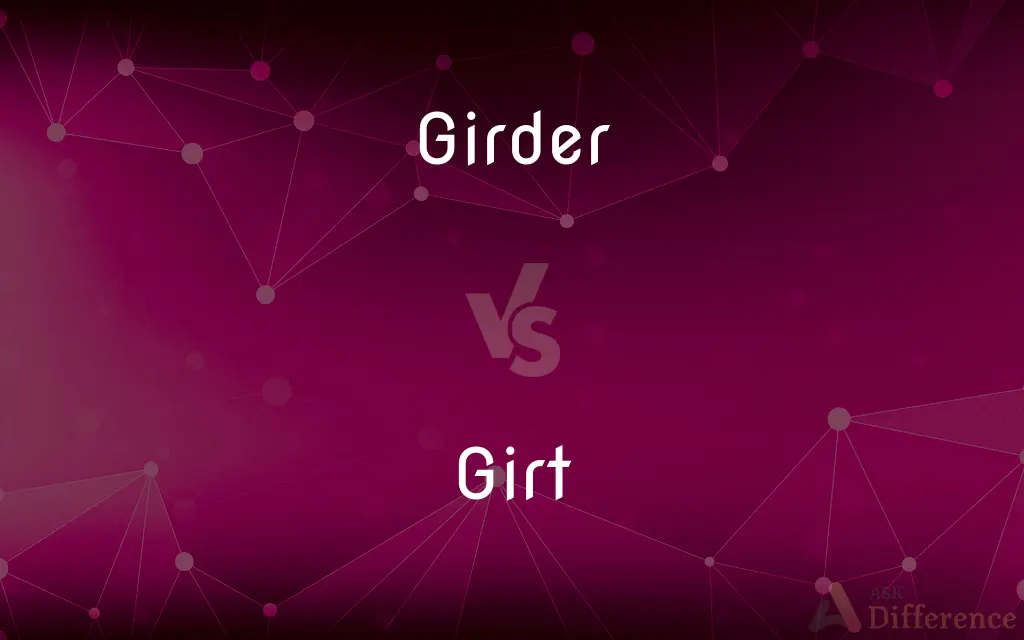Girder vs. Girt — What's the Difference?
By Urooj Arif & Maham Liaqat — Updated on March 28, 2024
A girder is a large, primary horizontal support beam in construction, while a girt is a secondary horizontal support typically used in metal buildings and for cladding attachment.

Difference Between Girder and Girt
Table of Contents
ADVERTISEMENT
Key Differences
Girders serve as the main horizontal supports in building and bridge construction, designed to bear large loads. They are key components in the framework, often supporting beams and other structural elements. Girders can be made from various materials, including steel, concrete, or wood, and are crucial for the structural integrity of large constructions. On the other hand, girts are horizontal structural elements used primarily in metal buildings or similar constructions, acting as secondary supports. They provide lateral support for wall cladding and can be integral to the stability of the structure, but they do not carry the same load as girders.
While girders are typically larger and bear more weight, functioning as the backbone for floor and roof structures, girts are smaller and serve to stiffen the walls and provide attachment points for exterior materials. Girders often require significant engineering and design work, given their critical role in the overall structure. In contrast, girts, though important, are part of a system of secondary supports and are standardized in many metal building systems.
In terms of installation and placement, girders are positioned to distribute weight and loads across a wide area, often spanning large distances and requiring precise calculations to ensure safety and stability. Girts are installed between columns or piers and are spaced at intervals determined by the building design, primarily focusing on the requirements for wall stability and cladding attachment rather than load-bearing capacity.
The terminology and specific uses of girders and girts reflect their roles in construction. Girders are often discussed in the context of major infrastructure projects, skyscrapers, and large commercial buildings, where their function and design are critical to the project's success. Girts, while also important, are more specific to certain types of construction, like metal buildings and structures where wall cladding is a significant consideration.
The material composition of girders and girts also differs based on their functions. Girders, needing to support significant weight, are constructed from materials with high strength and durability. Girts, while still made from sturdy materials, have specifications that prioritize ease of installation and compatibility with cladding materials, reflecting their role in the structural ensemble.
ADVERTISEMENT
Comparison Chart
Function
Primary horizontal support beam
Secondary horizontal support
Usage
Main support in buildings and bridges
Lateral support in metal buildings
Load Bearing
Designed to bear large loads
Provides stability and cladding support
Material
Steel, concrete, wood
Often steel in metal building systems
Placement
Spans large distances, crucial positions
Between columns, under cladding
Engineering
Requires extensive design and calculations
Standardized, part of secondary supports
Structural Role
Backbone for floor and roof structures
Stiffens walls, supports exterior materials
Project Context
Critical in large constructions
Important in metal buildings, specific uses
Compare with Definitions
Girder
Essential in large buildings.
Skyscrapers rely on girders for their structural framework.
Girt
Used in metal buildings.
Installing girts improved the structural rigidity of the shed.
Girder
Key to structural integrity.
Girders were installed to support the new bridge deck.
Girt
Enhances wall stiffness.
The addition of girts prevented the walls from buckling under wind pressure.
Girder
Made from durable materials.
Concrete girders form the backbone of the highway overpass.
Girt
Part of wall systems.
Girts were spaced evenly along the wall for exterior paneling.
Girder
Spans large distances.
The warehouse's roof was supported by long steel girders.
Girt
Supports cladding materials.
The girt system was designed for easy cladding attachment.
Girder
A primary support beam in construction.
The steel girder spanned across the building's foundation.
Girt
Secondary horizontal support.
Girts were added to the metal building for wall stability.
Girder
A girder is a support beam used in construction. It is the main horizontal support of a structure which supports smaller beams.
Girt
For the town in Armenia, see Kard, Armenia. In architecture or structural engineering, a girt, also known as a sheeting rail, is a horizontal structural member in a framed wall.
Girder
A large iron or steel beam or compound structure used for building bridges and the framework of large buildings
The tower is made of steel girders criss-crossed to make it stronger
Girt
To gird.
Girder
A beam, as of steel, wood, or reinforced concrete, used as a main horizontal support in a building or bridge.
Girt
To secure with a girth.
Girder
A beam of steel, wood, or reinforced concrete, used as a main horizontal support in a building or structure.
Girt
To measure the girth of.
Girder
One who girds; a satirist.
Girt
To measure in girth.
Girder
One who girds; a satirist.
Girt
A past tense and a past participle of gird1.
Girder
One who, or that which, girds.
Girt
A horizontal structural member of post and beam architecture, typically attached to bridge two or more vertical members such as corner posts.
Girder
A main beam; a stright, horizontal beam to span an opening or carry weight, such as ends of floor beams, etc.; hence, a framed or built-up member discharging the same office, technically called a compound girder. See Illusts. of Frame, and Doubleframed floor, under Double.
Girt
To gird.
Girder
A beam made usually of steel; a main support in a structure
Girt
To bind horizontally, as with a belt or girdle.
Girt
To measure the girth of.
Girt
Simple past tense and past participle of gird
Girt
(nautical) to capsize because of forces in the cable attaching it to another vessel.
Girt
(nautical) Bound by a cable; used of a vessel so moored by two anchors that she swings against one of the cables by force of the current or tide.
Girt
Alternative spelling of gurtin the sense 'great'.
Girt
To gird; to encircle; to invest by means of a girdle; to measure the girth of; as, to girt a tree.
We here create thee the first duke of Suffolk,And girt thee with the sword.
Girt
Bound by a cable; - used of a vessel so moored by two anchors that she swings against one of the cables by force of the current or tide.
Girt
Same as Girth.
Girt
Encircle or bind;
Trees girded the green fields
Common Curiosities
Is the installation of girders more complex than girts?
Yes, due to their critical load-bearing role, installing girders requires more precision and planning.
Are girts necessary in all metal buildings?
While not every metal building will use girts, they are common in structures where wall cladding is necessary.
How are girders different from beams?
Girders are primary support elements that can carry the load of beams, which are secondary elements.
Can girders be used in residential construction?
Yes, girders are used in residential construction, especially in homes with large spans or heavy loads.
How do engineers decide between using a girder and a girt?
The choice depends on the structural needs of the building, with girders for main support and girts for secondary support.
How are girders transported to construction sites?
Girders are transported using specialized equipment and vehicles due to their size and weight.
Can girts be used for purposes other than cladding support?
Primarily, girts are for cladding support and structural stability, though they may serve additional functions depending on the design.
Can girders be part of a residential building's aesthetic?
Yes, especially in modern architecture, where exposed girders can contribute to the aesthetic appeal.
How does weather impact the installation of girders and girts?
Weather can affect installation schedules and procedures, especially for outdoor projects requiring precise conditions.
Are there different types of girts?
Yes, there are different types of girts designed for specific applications and building designs.
How do material choices affect the performance of girders and girts?
Material choice impacts durability, strength, and the structural capabilities of both girders and girts.
Can girts contribute to a building's insulation?
Yes, when designed correctly, girts can play a role in the thermal insulation system of a building.
What maintenance is required for girders and girts?
Maintenance includes regular inspections for corrosion, damage, and connections' integrity.
What are the safety considerations when installing girders?
Safety considerations include proper handling, securing the girder during installation, and ensuring it can support the planned loads.
Can the design of girders and girts be customized?
Yes, both can be customized to meet specific architectural and structural requirements.
Share Your Discovery

Previous Comparison
Uracil vs. Uridine
Next Comparison
Exploration vs. ExploitationAuthor Spotlight
Written by
Urooj ArifUrooj is a skilled content writer at Ask Difference, known for her exceptional ability to simplify complex topics into engaging and informative content. With a passion for research and a flair for clear, concise writing, she consistently delivers articles that resonate with our diverse audience.
Co-written by
Maham Liaqat















































